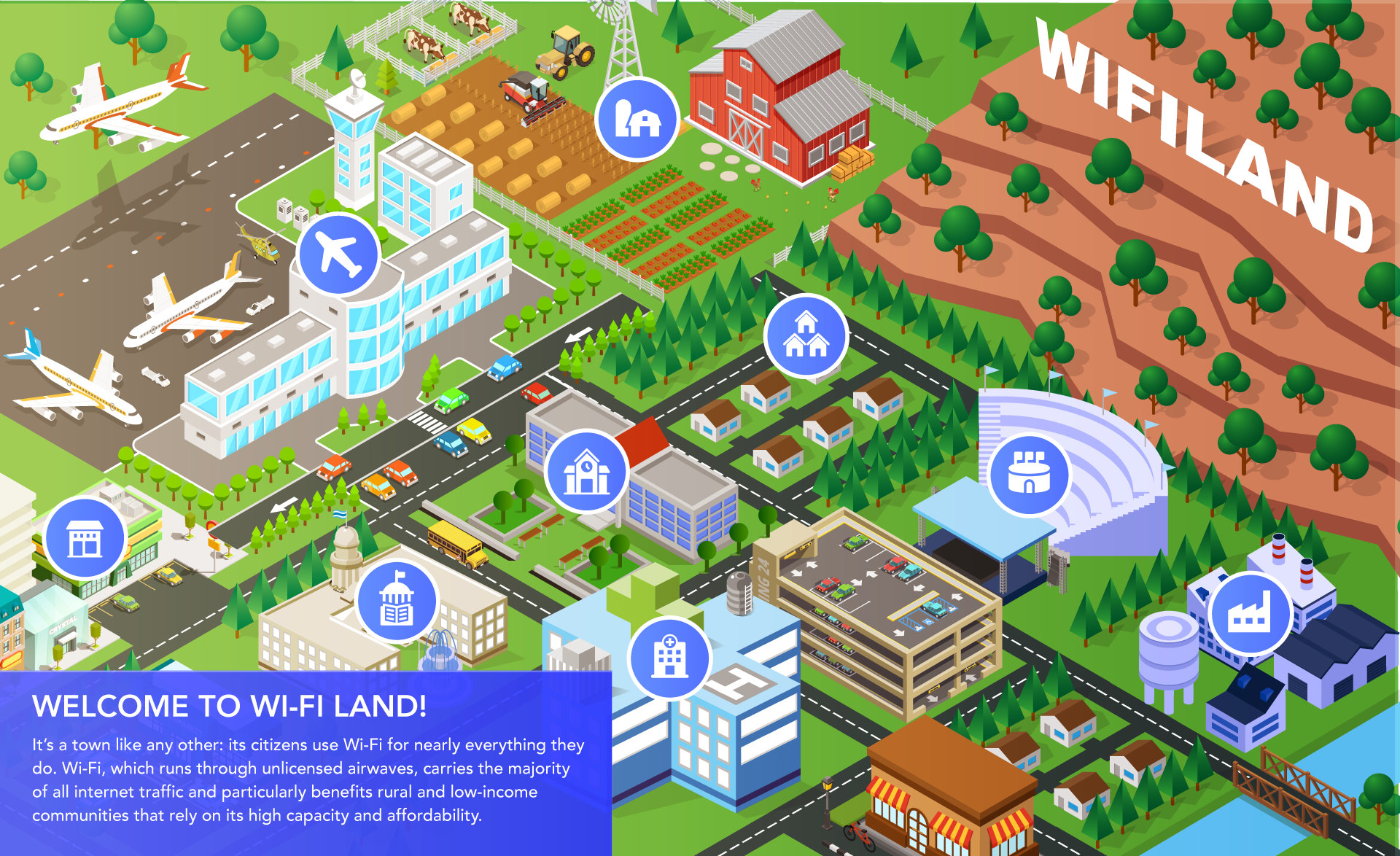Welcome to Wi-Fi Land
Explore the map to see how Wi-Fi Land's citizens use Wi-Fi for nearly everything they do.

Airports
- - Wi-Fi access at airports is vital for travelers to stay connected. Gate agents use Wi-Fi-enabled tablets to check in passengers to make sure everyone is in the right place.
- - Operations personnel and pilots use Wi-Fi-connected notebooks for airfield inspections and condition reports.
- - Airlines also use Wi-Fi for baggage reconciliation and security, both outside on the ramp and at baggage claim.
- More on Wi-Fi in our airports here.
Retail Stores and E-Commerce
- - Every major e-commerce and brick and mortar retailer runs on Wi-Fi. E-commerce orders do not ship without numerous Wi-Fi-based transactions.
- - Retail stores across the country use Wi-Fi to connect shoppers to services, assist with navigation within stores and monitor security threats to keep customers and merchandise safe.
- - Customers love Wi-Fi, too, and this drives sales for brick and mortar small businesses: once installing a public Wi-Fi network, 62% of businesses said customers spent more time in their shop or facility and 50% reported increased sales.
- More on Wi-Fi empowering small businesses here.
Smart Cities and Government Services
- Wi-Fi is a crucial tool for local communities:
- - Los Angeles uses a coordinated traffic light system to monitor traffic flow and change signals. The results: faster commutes and a reduction in carbon emissions.
- - First responders in DC use an extensive Wi-Fi network to get real-time information to better respond in emergencies.
- - Corpus Christi, TX built a network of 120,000 water and gas meters to monitor their water supply, detect leaks, conserve water and save taxpayers money.
- In the Smart City of the future, Wi-Fi will play an even greater role, affordably connecting large numbers of 5G IoT devices — everything from smart trash cans to connected ambulances.
Farms
- - Most farms using precision agriculture rely on mesh networks that relay Wi-Fi signals across many acres.
- - Farms depend on Wi-Fi to monitor crop yields and execute planting and harvesting schedules. Instruments in the field measure soil humidity, plant health, weather conditions and other environmental factors.
- - Now, even drones are being used to monitor crop health and relay information back to farmers over Wi-Fi.
- More examples of Wi-Fi at use in next-gen farms here.
Schools & Libraries
- - K-12 schools and college campuses across the country rely on Wi-Fi to connect students with the educational tools they need, both inside and outside the classroom.
In the pandemic, Wi-Fi serves as a lifeline between teachers and students in virtual or hybrid classrooms. - - For the millions of Americans who don’t have broadband at home, free library Wi-Fi bridges the digital divide and connects people to employment, homework help and other opportunities.
- More on what a hyper-connected classroom could look like here.
Connected Homes
- - More than 100 million U.S. households use Wi-Fi every day.
- - Wi-Fi is the primary way Americans experience broadband and will be the primary way they experience 5G indoors.
- - It enables the use cases Americans need every day like video conferencing, virtual school and digital banking and next-gen apps of the future like connected fridges, VR headsets and smart coffeemakers.
- More on Wi-Fi and the connected home here.
Stadiums
- - The problem of texts not going through at concerts and games will be a thing of the past with Wi-Fi 6 and Wi-Fi 6E.
- - With next-gen Wi-Fi, fans can video chat during the game, upload videos with AR-generated fan filters and check social media for the latest updates seamlessly.
- - For instance, Dodgers Stadium upgraded to Wi-Fi 6 in 2020. Learn more.
Hospitals
- - Modern hospital rooms have Wi-Fi-connected infusion pumps, oxygen monitoring devices, smart beds and more, which keep patients connected to the care team 24/7.
- - Wi-Fi in hospitals supports doctors and technicians with real-time access to X-rays, MRI scans and electronic health records.
- - New AR/VR applications powered by Wi-Fi will lead to new use cases like health care diagnostics, visualizations, displays for remote surgery and training for pediatric emergencies.
- - Telehealth delivered via Wi-Fi helps scale the provision of high-quality health care to remote and underserved areas.
- More from FierceHealthcare here.
Factories
- - Factories and plants use Wi-Fi to track activity on the floor, monitor equipment safety and relay information to the plant’s central hub if machinery malfunctions.
- - Product pickers and forklift operators in distribution centers depend on Wi-Fi to meet hourly productivity targets and to run assembly lines.
- More on Wi-Fi 6 and a successful trial at Mettis Aerospace’s facility here.
